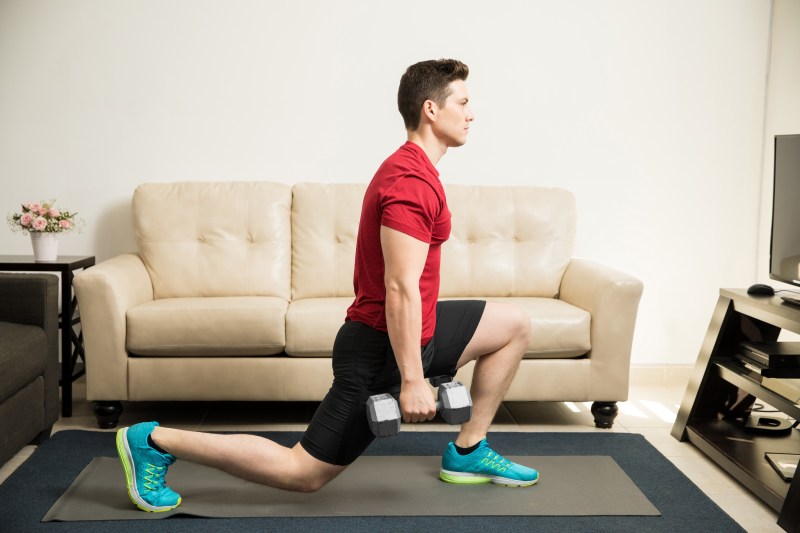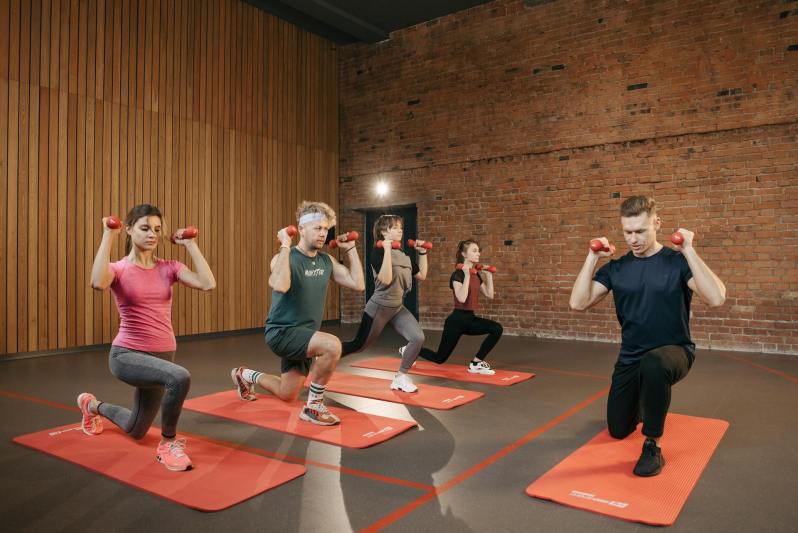Lunges are a classic exercise you see people doing at gyms, parks, and everywhere. This lower-body move targets your quadriceps, glutes, hamstrings, and calves, and you’ll engage your core for stability. It’s essentially taking a giant step forward and lowering your body weight down while maintaining your balance.
Once I’d conquered the old-fashioned lunge, I wanted to kick things up a notch with the dumbbell lunge, so I started with lighter weights. Dumbbell lunges are more difficult to maintain your balance. Over time, I went from shaky quads with the old-fashioned lunge to strong, sturdy quads with dumbbell lunges, and I love feeling stronger than when I started. Adding dumbbells works your legs and glutes even more.
Powerlifters and gym-goers often joke about how you shouldn’t ‘skip leg day’, and dumbbell lunges are an excellent strength training exercise to add to your lower-body workouts. Here’s your guide to dumbbell lunges, including the muscles worked, benefits, how to improve your technique, the best variations, FAQs, and more.
What are dumbbell lunges?

Dumbbell lunges are a variation of the traditional lunge exercise where you take a large step forward while holding dumbbells down at your sides. You lower your body weight with one leg in front of you, the other behind you, and both knees bent. Dumbbell lunges are often incorporated into lower-body strength routines and circuit training workouts.
What are the muscles worked?

When performing dumbbell lunges, you’ll work the following muscles:
- Quadriceps and hamstrings in your thighs.
- Glutes.
- Calves.
Secondary muscle groups worked are your trapezius muscles in your upper back, abductors in your thighs, and your core, including your obliques.
What are the benefits of dumbbell lunges?

The biggest benefits I found were my balance and quad strength.
Here are some of the many benefits of dumbbell lunges:
- Improve your grip strength.
- Strengthen your lower back as you try to stay balanced.
- Adding dumbbells emphasizes the engagement of those lower body muscles and helps tone your arms and shoulders.
- Get a serious quad workout.
- Stronger quads improve your balance and mobility and help with everything from walking uphill to climbing stairs and cycling.
- Improve your bone mineral density, which lowers your risk of falling and injury.
- Fine-tune your overall functional fitness and athletic performance.
- Enhance the flexibility of your legs and hips.
- Boost testosterone by working multiple muscle groups with this strength-training move.
- Work the larger muscles in your lower body, which helps you build muscle and reduce body fat.
Unilateral training

Dumbbell lunges are a unilateral exercise, which means they work one limb at a time. Unilateral exercises are effective for improving your balance and coordination and targeting your stabilizing muscles. You have to work a little harder to engage your core and stay upright and balanced.
How to do dumbbell lunges

Make sure you have room to take one big step and choose a suitable weight for the dumbbells. Always start with lighter weights if you’re a beginner, or you can perform the traditional lunge exercise without weights until you master your form.
How to do a dumbbell lunge:
- Start standing up straight, holding a dumbbell in each hand with your arms down by your sides.
- Your palms should face your thighs, and your feet should be slightly less than shoulder-width apart.
- Keep your torso upright and take a big step forward with your right leg.
- Plant your right heel on the floor and bend your right knee.
- Lower your body until your right thigh is nearly parallel to the ground. Your back leg should be balanced on your toes with your knee bent and almost touching the floor in the lunge position.
- Hold the pose for a moment before stepping your right foot back to return to the starting position.
- Repeat the exercise with your other leg.
Tips for proper form

Follow these top tips to perfect your technique and get the most out of this movement:
- Keep your upper body straight and your core engaged throughout.
- Incorporate progressive overload, where you gradually increase the weights over time to enhance strength and muscle growth.
- Try to keep your front knee aligned with your toes.
- Lower down slowly with control.
- Keep your back knee in line with your body and pointed in the direction of the ground.
Some experts and bodybuilders like Cliff Wilson have specific ways of performing dumbbell lunges to stay balanced and stable while still using heavy weights.
If you have pelvic instability or an ankle injury, it’s best to avoid dumbbell lunges. If you’re not sure if this exercise is suitable for you, you can consult with your healthcare provider or physical therapist.
Most common mistakes to avoid

Avoiding these common mistakes lowers your risk of injury while maximizing the effectiveness of dumbbell lunges:
- Rushing through the movement and dipping down too quickly.
- Leaning forward instead of keeping your torso upright.
- Extending your front knee past your toes.
- Turning your back knee inward or outward.
Fitness buffs like Trent Harrison find that misaligned knees are one of the most common mistakes people make, often leading to knee pain or discomfort.
Variations

You can try different variations of dumbbell lunges to mix up your workout schedule, such as:
- Take a shorter step — The length of your stride when you take a step forward into the lunge position affects which muscles are emphasized. If you take shorter steps forward, you’ll have more engagement in your quadriceps muscles.
- Take a longer step — If you take a longer step, you’ll better emphasize your glutes.
- Reverse lunges — Instead of stepping forward as you would with a traditional lunge, you step one leg back behind you into the reverse lunge position.
- Dumbbell walking lunge — Ramp up the cardio and try walking lunges where instead of returning back to the starting position, you continue to ‘lunge’ forward.
- Lateral dumbbell lunge — You can perform lateral lunges with a dumbbell or kettlebell. Hold the dumbbell with both hands at your chest and take a big step to the side with your foot turned slightly outward. Your other leg should be bent, supporting much of your weight with your foot pointing forward.
- Overhead walking lunge — You perform overhead walking lunges while holding one dumbbell in your hand with your arm straight up overhead.
FAQs

Are lunges with dumbbells effective?

Dumbbell lunges make your major lower body muscles work harder to help you stay balanced. It’s an effective exercise for strengthening your quad muscles and legs and boosting your flexibility.
Are lunges better for you than squats?

Both are effective exercises for your lower body muscles, so it’s worth adding both to your routine. Because lunges are a unilateral exercise that mostly works one side at a time, lunges improve muscular imbalances on different sides of your body and increase your stability. Squats are a bilateral exercise where both sides of your body work together. Squats also boost core stability and lower body strength.
What about reps and sets?

The right number of sets and reps for you depends on factors like your fitness level and goals. If you’re still becoming familiar with the exercise, start with a lighter weight and try two or three sets of eight to 10 reps with each leg, taking a break in between each set for 30 seconds to a few minutes. Generally speaking, if you’re more advanced and familiar with the exercise and you’re interested in building muscle, aim for six to 12 reps on each side with a moderate to heavier weight.
Do dumbbell lunges burn belly fat?

Losing belly fat requires more than just specific exercises alone, and factors like nutrition, hormones, body fat composition, and stress all play a role. Practicing lunges regularly can help tighten and tone up your abdomen area, but weight loss and body fat loss necessitate a multifaceted approach.
What happens if you do lunges every day?

While you can definitely do dumbbell lunges every day, and you should see results in terms of sculpting your body and building muscle mass, most fitness trainers and professionals don’t recommend it. It’s best to include a rest day in between sessions to give those muscle groups time to repair and recover.
How to incorporate dumbbell lunges into your training schedule

Adding dumbbell lunges into your training schedule provides plenty of benefits, including fine-tuning your balance and coordination and leveling up your lower body strength. Start with lighter weights or no weights and work your way up to performing more sets and reps with heavier weights over time. Don’t skip leg day; scorch your quads with dumbbell lunges instead.




